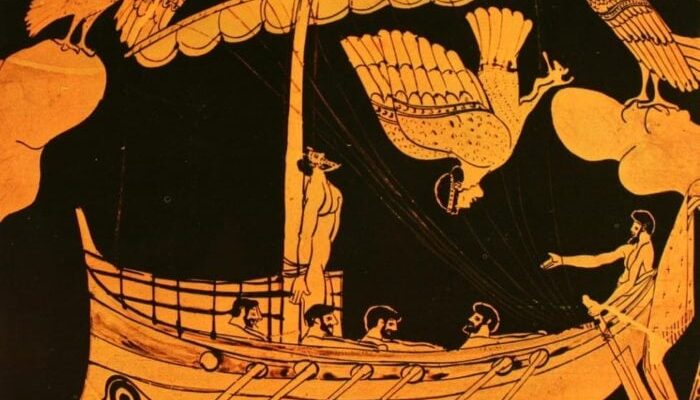
Mermaids, folkloric creatures with the head and upper body of a woman and lower body of a fish, appear in many cultures across the world. Many have traced the contemporary conception of a mermaid to the ancient Greek figure of the Siren, even though similar creatures can be found across the world.
Sirens were dangerous creatures in Greek mythology. The fearsome figures, which were described and depicted as half-woman and half-bird, sat perched on rocky crags along the sea, singing beautiful, seductive songs.
They hoped to ensnare nearby sailors, luring them onto the dangerous rocks with their songs, causing shipwrecks.
Ancient Greek Sirens influenced idea of mermaids
The most famous mention of a Siren in ancient Greek literature is the scene from Homer’s epic poem The Odyssey, in which Odysseus is warned by the sorceress Circe of the irresistible song of the Sirens.
Curious as to what he would hear, Odysseus ordered his crew to tie him to the mast of the ship, to not untie him until they passed the creatures, and to plug their own ears with beeswax.
Upon hearing their beautiful song, Odysseus begged his crew to release him, but they obediently sailed onward.
According to some ancient authors, the Sirens were fated to die if anyone heard their song and resisted; therefore, Odysseus was the first to kill the Sirens, who jumped to their deaths into the sea after he successfully fled.
While the ancient Greek Sirens do not exactly resemble mermaids, as they are half-bird, not half-fish, the creatures began to shift forms in antiquity.
By the Hellenistic period, Greek depictions of Sirens more clearly resembled the current image of mermaids, as beautiful, fish-tailed women; yet, the birdlike women were still found in art up until the Byzantine period.
In a ninth century Byzantine Greek text, the Sirens are depicted as aquatic creatures while in the tenth century Suda, they are portrayed as avian beings.
In medieval Christian bestiaries, the Sirens from Greek mythology are also depicted with a fish’s tail—not birds’ legs.
Many qualities of ancient Greek Sirens, such as their seductive and dangerous nature, was transferred onto beliefs about mermaids across Europe. In folklore across Europe, mermaids were said to have their own beautiful song that could lead sailors to their deaths.
Legends featuring mermaids
Although ancient Greek Sirens may have had the most influence on the modern conception of mermaids, it is hardly the oldest description of the creature.
The first known stories featuring mermaids come from Assyria and date back to 1000 BC. They tell the tale of the goddess Atargatis who loved a mortal man.
Tragically, she accidentally killed her lover and jumped into a lake, taking the form of a fish out of shame for her actions.
Despite her efforts, however, the waters could not hide her divine beauty, and she retained her human form from the waist up while keeping her fish tail.
This tale led to a stigma attached to eating fish in the region, according to Hellenized Syrian writer Lucian of Samosata, as many believed the goddess could take on the form of a fish.
The mermaid goddess Atargatis was known to the Greeks, who called her Derketo. Her transformation and story may have influenced later Greek depictions of the Sirens as fish-tailed.
Roman historian Pliny the Elder, who wrote in the first century AD, stated that there had been numerous sightings of mermaids along the coast of Gaul.
According to the ancient author, the governor of Gaul even wrote to the Emperor Augustus to inform him of the issue, as many bodies of mermaids completely covered in scales had washed up along the coast.
Thessaloniki, sister of Alexander the Great
In Ottoman Greece, a legend about Thessaloniki, Alexander the Great’s sister, began to emerge.
According to the story, Thessaloniki did not die but rather transformed into a mermaid at the moment of her death and lived in the Aegean Sea.
Legend has it that the mermaid would ask each ship she encountered: “Is King Alexander alive?” (“Ζει ο Βασιλεύς Αλέξανδρος;”)
The correct answer is “He lives and reigns and conquers the world” (“Ζει και βασιλεύει και τον κόσμον κυριεύει”).
Satisfied with the answer, it is said that the mermaid would calm any rough waters and wish the ship a safe journey.
Any other answer would enrage Thessaloniki, who would stir up a tremendous storm which would wreck the ship and kill the crew.
Mermaids embodied fears of the sea
For much of history and in many places to this present day, sailing the open seas can be extremely dangerous. Historically, many sailors who left for long nautical voyages never returned home.
These fears of death and injury were often centered on mythical creatures such as sea monsters and mermaids, and there are many records of sailors spotting mermaids while on journeys across the sea.
Christopher Columbus himself claimed to have seen many mermaids while exploring the Caribbean.
Most contemporary historians and experts believe that these sightings were likely of manatees and similar aquatic mammals like seals.



